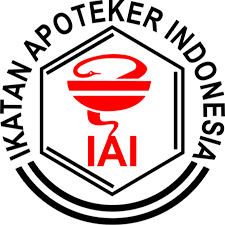Purification of Curcumin Derivate (1,5-bis(4’-hydroxy-3’-methoxyphenyl)-1,4-pentadien-3-on) Using Chromatotron
Sabtanti Harimurti(1*), Alfan Fadhilah(2), Hari Widada(3), Vella Lailli Damarwati(4)(1) School of Pharmacy, Faculty of Medicine and Health Sciences, Universitas Muhammadiyah Yogyakarta, Indonesia, Jl. Brawijaya, Tamantirto, Kasihan, Bantul, Yogyakarta, 55183, Indonesia
(2) School of Pharmacy, Faculty of Medicine and Health Sciences, Universitas Muhammadiyah Yogyakarta, Indonesia, Jl. Brawijaya, Tamantirto, Kasihan, Bantul, Yogyakarta, 55183, Indonesia
(3) School of Pharmacy, Faculty of Medicine and Health Sciences, Universitas Muhammadiyah Yogyakarta, Indonesia, Jl. Brawijaya, Tamantirto, Kasihan, Bantul, Yogyakarta, 55183, Indonesia
(4) School of Pharmacy, Faculty of Medicine and Health Sciences, Universitas Muhammadiyah Yogyakarta, Indonesia, Jl. Brawijaya, Tamantirto, Kasihan, Bantul, Yogyakarta, 55183, Indonesia
(*) Corresponding Author
Abstract
Keywords
Full Text:
PDFReferences
Agrawal, V., & Desai, S., 2015. Centrifugally accelerated thin layer chromatography for isolation of marker compounds and bioactives. Journal of Pharmacognosy and Phytochemistry, 3(6), 145–149.
Atun, S., 2014. Metode Isolasi dan Identifikasi Struktural Senyawa Organik Bahan Alam. Borobudur, 8(2), 53–61. https://doi.org/10.33374/jurnalkonservasicagarbudaya.v8i2.132
Balasubramanyam, M., Koteswari, A. A., Kumar, R. S., Monickaraj, S. F., Maheswari, J. U., & Mohan, V., 2003. Curcumin-induced inhibition of cellular reactive oxygen species generation: Novel therapeutic implications. Journal of Biosciences 2003 28:6, 28(6), 715–721. https://doi.org/10.1007/BF02708432
Harimurti, S., Setyonugroho, W., & Pramono, A., 2019. Energy Savings on Curcumine Derivative Gamavuton-0 Synthesis Using Microwave Irradiation. International Journal of Applied Pharmaceutics, 11(3), 155–158. https://doi.org/10.22159/IJAP.2019V11I3.31979
Jandera, P., & Churáček, J., 1981. Advances in Chromatography (pp. 125–260). Boca Raton: CRC Press. https://doi.org/10.1201/9781003209690-5
Móricz, M., & Vovk, I., 2016. Centrifugal layer chromatography—Rotation planar chromatography in Forced-Flow Layer Chromatography (pp. 187–222). https://doi.org/10.1016/B978-0-12-420161-3.00003-4
Muti’ah, R., 2015. Evidence Based Kurkumin dari Tanaman Kunyit (Curcuma longa) sebagai Terapi Kanker pada Pengobatan Modern. Journal of Islamic Pharmacy, 1(1), 28–41. https://doi.org/10.18860/JIP.V1I1.4178
Raflizar, R. (Raflizar), & Nainggolan, O. (Olwin)., 2010. Faktor Determinan Tumor/kanker Kulit di Pulau Jawa (Analisis Data Riskesdas 2007). Buletin Penelitian Sistem Kesehatan, 13(4), 21319. https://doi.org/10.22435/BPSK.V13I4
Sabet, S., Rashidinejad, A., Melton, L. D., & McGillivray, D. J., 2021. Recent advances to improve curcumin oral bioavailability. Trends in Food Science & Technology, 110, 253–266. https://doi.org/10.1016/J.TIFS.2021.02.006
Safitri, C., Ritmaleni, R., Rintiswati, N., Sardjiman, S., & Kaneko, T., 2018. Antimycobacterial Activity of Benzylidene Acetone analogues of Curcumin Againts Resistant and Sensitive Mycobacterium tuberculosis. IOSR JDMS, 16(12), 21–26.
Sardjiman, S. S., Reksohadiprodjo, M. S., Hakim, L., Van Der Goot, H., & Timmerman, H., 1997. 1,5-Diphenyl-1,4-pentadiene-3-ones and cyclic analogues as antioxidative agents. Synthesis and structure-activity relationship. European Journal of Medicinal Chemistry, 32(7–8), 625–630. https://doi.org/10.1016/S0223-5234(97)83288-6
Singh, N., Kumar, A., Gupta, V. K., & Sharma, B., 2018. Biochemical and Molecular Bases of Lead-Induced Toxicity in Mammalian Systems and Possible Mitigations. Chemical Research in Toxicology, 31(10), 1009–1021. https://doi.org/10.1021/acs.chemrestox.8b00193/
Siviero, A., Gallo, E., Maggini, V., Gori, L., Mugelli, A., Firenzuoli, F., & Vannacci, A., 2015. Curcumin, a golden spice with a low bioavailability. Journal of Herbal Medicine, 5(2), 57–70. https://doi.org/10.1016/j.hermed.2015.03.001
Tønnesen, H. H., 2002. Solubility, chemical and photochemical stability of curcumin in surfactant solutions. Studies of curcumin and curcuminoids, XXVIII. Die Pharmazie, 57(12), 820–824. https://europepmc.org/article/med/12561244
Valko, M., Jomova, K., Rhodes, C. J., Kuča, K., & Musílek, K., 2015. Redox- and non-redox-metal-induced formation of free radicals and their role in human disease. Archives of Toxicology 2015 90:1, 90(1), 1–37. https://doi.org/10.1007/S00204-015-1579-5
Yalkowsky, S. H., & Alantary, D. 2018. Estimation of Melting Points of Organics. Journal of Pharmaceutical Sciences, 107(5), 1211–1227. https://doi.org/10.1016/j.xphs.2017.12.013
Article Metrics
Abstract view(s): 606 time(s)PDF: 594 time(s)
Refbacks
- There are currently no refbacks.








